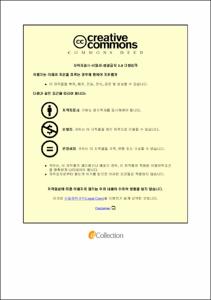기후변화 완화를 위한 옥상녹화의 도시재생 적용 및 생태효율성 평가
- Alternative Title
- Eco-efficiency evaluation and application of green roof to urban regeneration for mitigating climate change
- Abstract
- This study focused on the energy consumed by buildings that are the main source and cause of GreenHouse Gas(GHG) to mitigate Climate change. And chose Green roof as a method to reduce energy use. Because Green roof is classified as an eco-friendly construction method due to the effects of air purification, mental stability of plants and removal of fine dust. But, it requires the injection of many materials, making it a concern about potential environmental pollution, and has disadvantages that cannot be revitalized well with high investment costs. Relatively inexpensive low material cool roof are activated, but cool loops are also made of artificial materials and need to be repainted with a short life cycle, which is a potential environmental concern.
We want to find out what the more sustainable construction method is through environmental, economic and Eco-efficiency assessments of Green roof and Cool roof, which have different strengths and weaknesses.
The research period was set at 40 years, while Extensive Cool roof and water-based Cool roof were adopted and conducted. The results are as follows;
First, the extensive green roof is more environmentally friendly in the long run. Although Green roof consumes more material than cool roof, most of the materials that make up Green roof can be reused and recycled, and the plants in Green roof absorb CO2 through photosynthesis. This is because even the energy saving effect of heating and cooling offsets both the use case and GreenHouse Gas produced in 32 years.
On the other hand, Cool roof is stacked in layers on a regular basis and consists of only artificial materials, a lot of contaminants occur when disposed of them.
Second, the cool roof is more economical than the green roof.
Since the total cost of producing and using Green roof is 1.7 times the total cost of Cool roof, it is more economical to do so.
Third, Green Roof is more sustainable than Cool Roof.
As a result of environmental assessment and economic assessment, Green Roof is more environmentally friendly but less economical than Cool Roof. However, after calculating the secondary effects of Green roof as economic values, Green roof showed higher ecological efficiency than the Cool roof.
Finally, the project sites for urban regeneration were selected to calculate the amount of GreenHouse Gas that are reduced after introduction of Green roof, and the economic costs were calculated. The urban regeneration project was able to install Green roof of all buildings located in the target area and confirm that 191274 trees aged 30 removed the amount of GreenHouse Gas they absorb for a year.
In short, Green Roof is superior to Cool Roof in terms of environmental, economic value and sustainability. In addition, it is believed that the long-term and public-friendly urban regeneration projects and the integration of Green roof will alleviate urban environmental problems and climate change.
- Issued Date
- 2020
- Awarded Date
- 2020. 2
- Type
- Dissertation
- Publisher
- 부경대학교
- Alternative Author(s)
- Su Ryun Lee
- Affiliation
- 부경대학교 대학원
- Department
- 대학원 생태공학과
- Advisor
- 정용현
- Table Of Contents
- Ⅰ. 서론 1
Ⅱ. 이론적 배경 5
1. 도시재생(Urban Regeneration) 5
가. 도시재생의 정의 5
나. 도시재생 유형 및 현황 6
2. 옥상녹화(Green roof) 8
가. 옥상녹화 정의 8
나. 옥상녹화 효과 10
다. 옥상녹화와 LCA 13
3. 전과정 평가(Life Cycle Assessment, LCA) 15
가. 전과정 평가의 배경 15
나. 전과정 평가의 정의 15
다. 전과정 평가의 방법 16
4. 생애주기비용(Life Cycle Cost. LCC) 20
가. 생애주기비용 분석법의 배경 20
나. 생애주기비용 분석법의 정의 20
다. 생애주기비용 분석법 21
5. 생태효율성(Eco-efficiency) 24
가. 생태효율성의 배경 24
나. 생태효율성의 정의 24
다. 생태효율성의 지표 25
Ⅲ. 연구 내용 26
1. 연구 모델 설정 26
가. 대상지 선정 26
나. 건물 설계 28
다. 옥상녹화 시스템 설계 29
라. 쿨루프 설계 30
2. 환경영향 분석 31
가. 연구 목적 및 범위 정의 31
나. 데이터 수집 34
다. 영향평가 범주 및 방법 35
라. 가정 및 제한사항 37
3. 경제성 분석 39
가. 연구 목적 및 범위 정의 39
나. 데이터 수집 41
4. 생태효율성 평가 43
가. 연구 목적 및 범위 정의 43
Ⅳ. 연구 결과 및 고찰 44
1. 전과정 목록분석 결과 44
2. 환경영향 분석 결과 48
가. 옥상녹화 48
나. 쿨루프 63
3. 경제성 분석 결과 67
가. 옥상녹화 67
나. 쿨루프 68
4. 경제적 가치 분석 결과 70
가. 주말농장의 대체로 절약한 교통비 70
나. 냉·난방 에너지 절약 비용 71
5. 생태효율성 평가 결과 74
가. 환경영향 분석 74
나. 경제적 가치 분석 75
다. 생태효율성 분석 75
6. 대상지역에 대한 적용 및 고찰 77
가. 경제성 평가 적용 77
나. 환경성 평가 적용 78
Ⅴ. 결론 79
참고문헌 83
- Degree
- Master
- Files in This Item:
-
-
Download
 기후변화 완화를 위한 옥상녹화의 도시재생 적용 및 생태효율성 평가.pdf
기타 데이터 / 1.82 MB / Adobe PDF
기후변화 완화를 위한 옥상녹화의 도시재생 적용 및 생태효율성 평가.pdf
기타 데이터 / 1.82 MB / Adobe PDF
-
Items in Repository are protected by copyright, with all rights reserved, unless otherwise indicated.